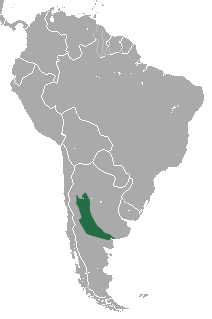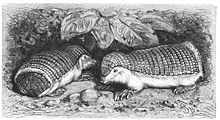Pink fairy armadillo
| Pink fairy armadillo[1] | |
|---|---|
| File:Pink fairy armadillo cropped.JPG | |
| Scientific classification | |
| Kingdom: | |
| Phylum: | |
| Class: | Mammalia purol
|
| Order: | |
| Family: | |
| Subfamily: | |
| Genus: | Chlamyphorus Harlan, 1825
|
| Species: | C. truncatus
|
| Binomial name | |
| Chlamyphorus truncatus Harlan, 1825
| |

| |
| Pink fairy armadillo range | |
The pink fairy armadillo (Chlamyphorus truncatus) or pichiciego is the smallest species of armadillo (mammals of the family Dasypodidae, mostly known for having a bony armor shell). It is found in central Argentina, where it inhabits dry grasslands and sandy plains with thorn bushes and cacti.
Characteristics

The pink fairy armadillo is approximately 90–115 mm (3.5-4.5 inches) long, excluding the tail, and is pale rose or pink in color. It has the ability to bury itself completely in a matter of seconds if frightened.
It is a nocturnal animal. It burrows small holes near ant colonies in dry soil, and feeds mainly on ants and ant larvae near its burrow. Occasionally, it feeds on worms, snails, insects and larvae, or various plant and root material.
The pink fairy armadillo spends much of its time under the ground, as it is a "sand swimmer" similar to the golden mole or the marsupial mole.[citation needed] It uses large front claws to agitate the sand, allowing it to almost swim through the ground like it is water. It is torpedo-shaped, and has a shielded head and back.
Status

In 1996, the species was classed as endangered by the IUCN,[2] then upgraded to "near threatened" in 2006, and in 2008 changed to "data deficient",[2] despite concern over habitat destruction, particularly due to cattle farming.[2]
This armadillo is found in several protected areas, including the Lihué Calel National Park.[2] Both national and provincial legislation is in place specifically protecting the species.[2]
References
- ^ Gardner, A. (2005). Wilson, D.E.; Reeder, D.M. (eds.). Mammal Species of the World: A Taxonomic and Geographic Reference (3rd ed.). Johns Hopkins University Press. p. 96. ISBN 978-0-8018-8221-0. OCLC 62265494.
- ^ a b c d e f Template:IUCN2011.1

